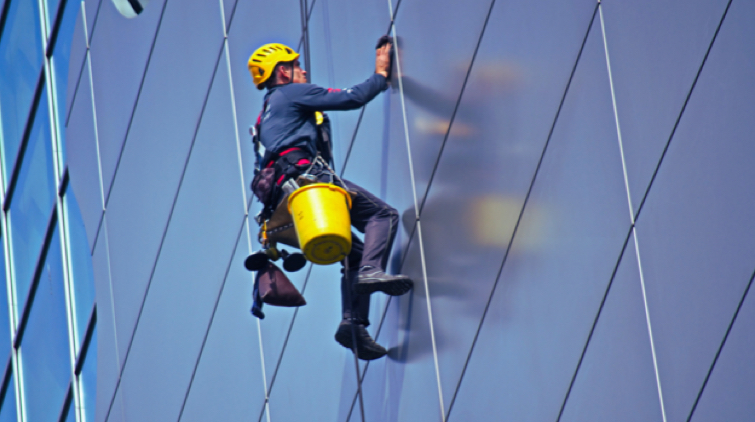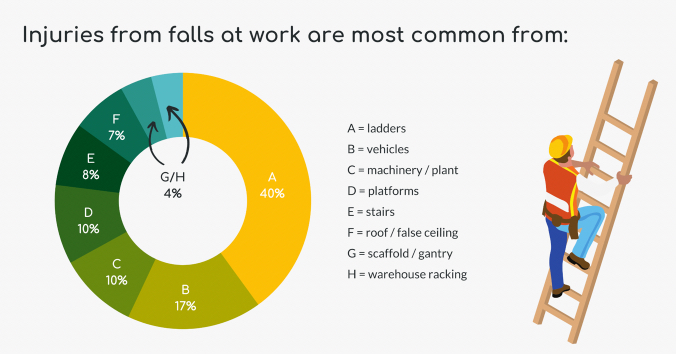Working at heights regulations
Working at heights is a hazard for workers in multiple job roles in sectors including construction, emergency services and tree work. The consequences of falling from heights are serious injury or mortality, so it is little surprise that extensive legislation covers working high above the ground.
For lone workers, heights represent an even greater hazard than for operatives in teams. Government guidance cover key issues on:
- planning and organising work
- assessing the competence of workers and supervisors
- equipment being used, including maintenance and inspection
- fragile or dangerous surfaces such as weak roofs
Without a colleague nearby, the measures taken for lone worker safety need to be thoroughly prepared and implemented. Without doing so, workers are at risk of injury, and employers can be liable for compensation and in extreme cases, for criminal charges.
What is working at heights?
Working at heights can be defined in different ways, but essentially means working where there could be a dangerous fall. Various measures are quoted, but careful consideration should be given for anyone working at four feet or more above ground.
Given the fact that a fall on ground level can still result in injury, a fall from any height needs to be viewed as potentially dangerous. If lone working involves equipment such as ladders, scaffolding, harnesses and elevated platforms, there needs to be a clear approach to the best way of keeping workers safe.
Which industries involve working at heights
Construction involves working on scaffolding for many activities including roofing, bricklaying, carpentry, glazing, rendering and finishing. Cranes with high cabs for drivers are a feature of building sites, docks and loading hubs. In the transport sector, drivers and maintenance staff need to clamber over large road vehicles and railway rolling stock. In the utilities and service industries, staff work on high power lines and communications cables, as well as at power stations. Working at heights is very much part of life in multiple other sectors including forestry, engineering, agriculture, warehousing and field services.
Which jobs involve working at heights?
Working at heights is a core part of job roles throughout industry and the service sector. The list of jobs is hugely extensive and includes:
- firefighter
- lighting technician
- steelworker (eg on bridges, elevated roadways, industrial plants)
- tree surgeon
- wind turbine technician
- window cleaner
- crane operator
- scaffolder
- builder
- roofer
- power line workers
- bridge painters
- crane operators
- warehouse operative
- rock climbing instructor
Specific skills are associated with every different role and the approach to safety varies too. Each role requires different equipment, such as harnesses for tree workers and ladder locks for window cleaners.
Working at heights injuries
Where vehicles are involved, 35% of cases are recorded as falls from the back of a lorry, 31% from standing on the forks of a forklift, 17% from lorry cab or tanker steps and 9% from the top of a vehicle.
The causes of the majority of falls at work are accounted for by slips and trips, falling objects, faulty work platforms, scaffolding and ladders, fragile roofing and bad weather.
Working at heights risk assessment
Falling from heights at work has severe implications for workers and management. Risk assessments are an essential part of the approach to worker safety for any organisation, and involve a process of assessment, taking precautions, recording findings and review.
Risk assessments for working at heights need to take account of specific issues for different types of equipment and different situations such as roof work, fragile structures, ladders and scaffolding. OSHA (The Department of Labor’s Occupational Health and Safety Administration) Health and Safety Executive) provides informative guides and checklists targeted at scaffolding and roofing, both of which include useful information for other sectors.
Working at heights safety
The right approach to safe working at heights needs awareness of do’s and don’ts. The approach to follow includes:
- work with feet on the ground whenever possible
- make sure workers can get up to high levels safely
- use the right equipment for the job, and keep it in good order
- take special care near fragile surfaces
- supply workers with protection from falling objects
- have clear emergency and rescue procedures in place to heights
Avoid
- overloading and overreaching on ladders
- resting ladders against glass, gutters and other weak supports
- carrying heavy loads on ladders
- working on ladders for more than 30 minutes
- allowing workers who don’t know how to work on ladders, or are not physically able to do so
The appropriate use of safety equipment is a key issue for employers to meet their legal obligations. Nets, airbags, harnesses and safety lines need to be deployed for safe working, as well as other equipment for restraining workers from falling.
Safety apps for working at heights
Modern technology can make a major contribution to safe working at heights, especially for lone workers. The key questions to ask when purchasing a safety app are about your needs and your options.
The best mobile lone worker apps allow easy communication and monitoring for staff in virtually any isolated working environment. They will also be straightforward to run on mobile phones. Once installed, they will feed directly into a monitoring and control centre with functions such as check-ins, timed sessions, panic alarms and man down alerts. They will also allow direct calls and messaging to other members of the organisation.
Lone worker apps with satellite tracking are setup to work in all environments, and are an important safety asset for remote sites where normal phone networks are unreliable or unavailable. Wearable technology is also a key part of lone worker safety apps, allowing workers to use the app hands free. In situations where discreet communication is required, such as in the presence of a potential attacker, wearable apps can be hidden under clothing and operate with a swift, unnoticeable action.
To see how StaySafe can help you protect your lone workers, 24/7, wherever they are, book your free demo today.
Are you protecting your lone workers?

Don CameronCEO, StaySafe
Don has been leading the growth of StaySafe since 2014, and we are now the leading, global, app-based lone worker solution.
Before coming over to StaySafe, Don built up over 25 years experience developing successful businesses in the IT, Telecoms and service industries.
Passionate about lone worker safety, Don is constantly striving to make sure StaySafe brings the most benefits to lone workers and their employers to keep more people safe.
Explore our range of lone worker solutions
See StaySafe in action
- 2 week free trial
- See how employees can use the app to check-in & send alerts
- See realtime updates in the monitoring hub
Guide to Lone Working
A comprehensive lone worker guide for employers, managers and the self employed.
Lone Worker Risk Assessment
Three Questions to Ask When Purchasing a Lone Working Solution
Find out more about StaySafe solutions

Lone Worker App
Our intuitive app allows employees to check in safely following a lone working session and raise an alert in an emergency.

Cloud Based Monitoring Hub

Wearable Technology












